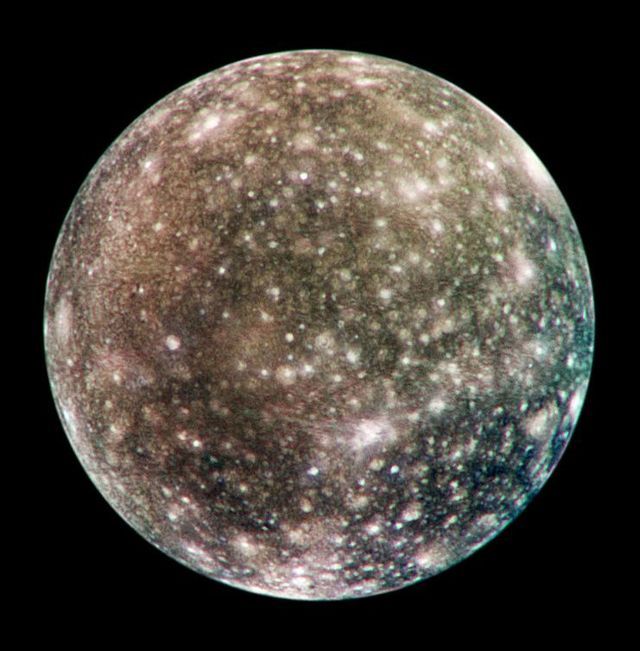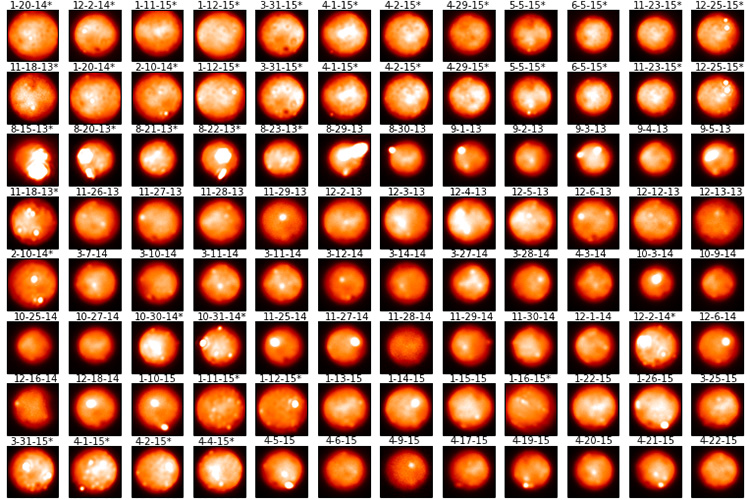

The lighter regions display extensive series of troughs and ridges, thought to be a result of tectonic movement." The largest dark region is named Galileo Regio and is almost 2000 miles in diameter. The darker regions are more heavily littered with craters implying that those regions are older. The surface includes mountains, valleys, craters and lava flows. "Ganymede has a very distinct surface with bright and dark regions. They were discovered independently by Galileo Galilei and Simon Marius." The Galilean Moons is a "name given to Jupiter's four largest moons, Io, Europa, Callisto & Ganymede. "If Ganymede rotated around the Sun rather than around Jupiter, it would be classified as a planet." Credit: National Oceanic and Atmospheric Administration/USGS. Main articles: Rocks/Rocky objects/Ganymede and Ganymede A true color image of Ganymede is acquired by the Galileo spacecraft on June 26, 1996. This image was taken on September 7, 1996, at a range of 677,000 kilometers (417,900 miles) by the solid state imaging television camera onboard the Galileo spacecraft during its second orbit around Jupiter.

This crater has been provisionally named "Pwyll" for the Celtic god of the underworld.

The bright feature containing a central dark spot in the lower third of the image is a young impact crater some 50 kilometers (31 miles) in diameter. Long, dark lines are fractures in the crust, some of which are more than 3,000 kilometers (1,850 miles) long. Bright plains in the polar areas (top and bottom) are shown in tones of blue to distinguish possibly coarse-grained ice (dark blue) from fine-grained ice (light blue). Dark brown areas represent rocky material derived from the interior, implanted by impact, or from a combination of interior and exterior sources. The view on the right is a false-color composite version combining violet, green and infrared images to enhance color differences in the predominantly water-ice crust of Europa. The left view shows the approximate natural color appearance of Europa. The image is a composite of two views of Europa. Credit: NASA/Deutsche Forschungsanstalt für Luft- und Raumfahrt e.V., Berlin, Germany. Main articles: Rocks/Ice sheets/Europa and Europa This image shows two views of the trailing hemisphere of Jupiter's ice-covered satellite, Europa. The image was taken on September 17th, 1997 at a range of 9200 kilometers (5700 miles) by the Solid State Imaging (SSI) system on NASA's Galileo spacecraft during its tenth orbit of Jupiter." The resolution is about 90 meters (295 feet) per picture element. The image, centered at 27.1 degrees north latitude and 142.3 degrees west longitude, covers an area approximately 80 kilometers (50 miles) by 90 kilometers (55 miles). Such images of Callisto help us understand the dynamics of giant impacts into icy surfaces, and how the large structures change with time." One explanation is that material from raised features (such as the ridge) may slide down slope and cover small scale features. The fine texture is not as visible in the middle of the image. Still peppered with craters, the number of icy bumps decreases while their average size increases. Exterior to the ring (lower left corner), Callisto's surface changes significantly. "The ridge that cuts diagonally across the lower left corner is one of many giant concentric rings that extend for hundreds of kilometers outside Asgard's center. What caused the bumps to form is still unknown, but they are associated clearly with the impact that formed Asgard." At low resolution, these icy bumps make Asgard's center brighter than the surrounding terrain. "This fascinating region of Jupiter's icy moon, Callisto, shows the transition from the inner part of an enormous impact basin, Asgard, to the outer "surrounding plains." Small, bright, fine textured, closely spaced bumps appear throughout the inner part of the basin (top of image) and create a more fine textured appearance than that seen on many of the other inter-crater plains on Callisto. This region of Callisto shows the transition from the inner part of an enormous impact basin, Asgard, to the outer surrounding plains. Credit: NASA/JPL/DLR(German Aerospace Center).Ībove is a complete global color image of Callisto. Callisto This image of Callisto from NASA's Galileo spacecraft, taken in May 2001, is the only complete global color image of Callisto obtained by Galileo.


 0 kommentar(er)
0 kommentar(er)
